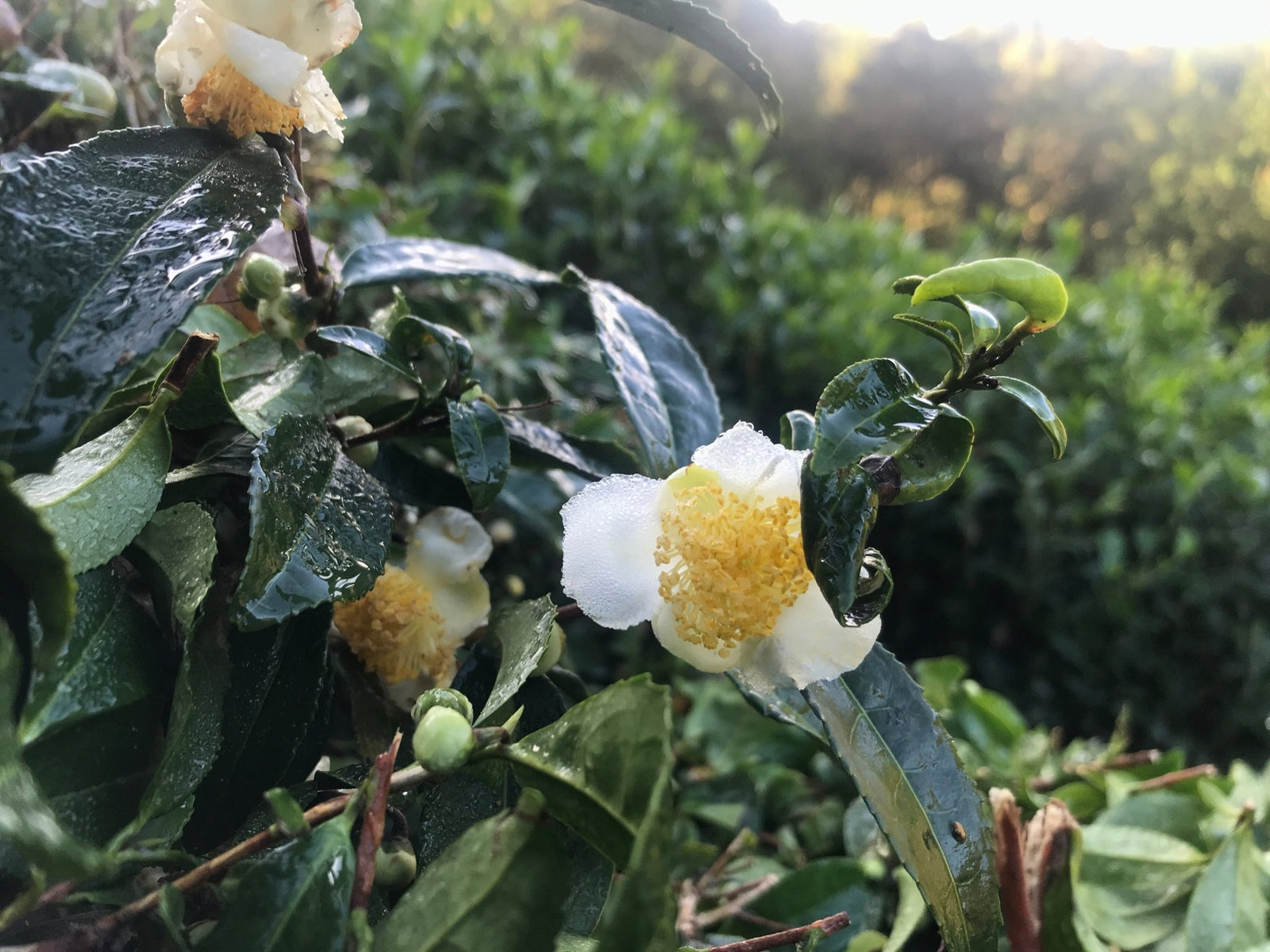みなさんこんにちは!
栗、柿、梨といった秋の味覚とともに、日本茶をお楽しみいただければ幸いです(お住まいの地域では、どんな秋の味覚がありますか?)。茶農家によっては、秋は収穫期(秋番茶)の時期です。収穫されたお茶は品質が劣るため、主にボトル入りのお茶や緑茶風味のお菓子などに利用されます。また、チャノキ(学名:C. amellia sinensis )を観察できる時期でもあります。 お茶の収穫だけでなく、日本では10月は稲刈りの美しい時期です。Yunomiの茶農家さんたちは、稲作もしながら田んぼで一生懸命働いたり、豊作を祝ったりしているかもしれませんね。日本の主要な茶産地に関するブログ記事は、これまで九州に焦点を当ててきましたが、皆さんの好奇心を刺激したり、新しい情報を提供したりできたことを願っています。個人的には、 釜炒り茶に興味を持ち、朝のお茶として楽しんでいます。いつもの蒸し茶とは違った味わいで、良い気分転換になっています。

九州地方には素晴らしい産地が数多くありますが、そろそろ別の地域へと話題を移しましょう。今日は、日本の新たな主要茶産地、京都府を取り上げます。京都府は、日本の都道府県の中で、茶の生産面積と生産量の両方で第4位です。また、多くの方がご存知の通り、京都は日本茶と茶道の中心地として広く知られています。宇治、宇治田原、和束、南山城、木津といった有名な茶産地は、 京都と奈良(日本の古都)という二つの大都市の間に位置し、木津川の流域に位置しています。今日の投稿では、特に宇治に焦点を当てます。宇治は日本で最も古く、おそらく最も尊敬されている茶産地です。しかし、宇治と宇治茶に関するアクセスしやすい関連情報はインターネット上(つまり英語で!)に既に豊富に存在するため、今回は気候変動とそれが宇治の茶農家とテロワール(土壌)にどのような影響を与えているかに焦点を当てたいと思います。
宇治茶の歴史
宇治は、皆さんもご存知の通り、日本茶発祥の地であり、おそらく日本で最も有名な茶の産地でしょう。茶の生産の歴史は鎌倉時代(1185-1333)に遡ります。禅僧の栄西は、12世紀後半の中国旅行から茶の種を京都に持ち帰ったことで有名です。栄西は禅を伝えただけでなく、中国から持ち帰った茶の種の一部を高山寺の明恵上人(上人は高僧の地位を示す)に伝えたと言われています。そのため、明恵は京都で最初の茶樹を、高山寺があった栂尾深瀬という場所で栽培したとされています。これらは、明恵が日本中に茶を飲む楽しみを広めるために行った最初のステップの一部でした。おそらく彼は、茶樹の移植(苗木が移植できる状態になった後)と大規模な茶栽培の場所に宇治を選んだとき、宇治の理想的な生育条件を認識していたのでしょう。
宇治の土壌の質の良さや地形など、お茶にとって最適な条件が揃ったため、茶の栽培は急速に拡大しました。1400年代半ばには、お茶を趣味として、また芸術として楽しむ習慣が広まり始めました。宇治茶は一流の贈り物とみなされるようになり、「闘茶」と呼ばれる一種の茶賭博ゲームさえも、この時代の知識人や上流階級の間で人気を博しました。このゲームは、出された抹茶が宇治地方で栽培された「本茶」か、それともあまり知られていない他の地域で栽培された「秘茶」かを当てるというものでした(注:闘茶は現在も行われていますが、抹茶ではなく玉露や煎茶が使われるのが一般的です)。その後、お茶を飲むことと料理を組み合わせる文化が生まれました。16世紀末には、茶道具や茶室の装飾の美しさを称える日本の茶道「茶の湯」が生まれました。日本における最高の茶学者と称される千利休は、茶道の普及と茶の湯の名声向上に貢献しただけでなく、 「侘び寂び」の精神を茶道に取り入れる上で重要な役割を果たしました。宇治抹茶法と蒸し法の発展に続き、宇治地方は高品質な抹茶と玉露の産地としても有名になり、その伝説は今日まで受け継がれています。

今日の宇治茶
宇治茶は、日本三大銘茶(宇治茶、静岡茶、狭山茶)の一つとされています。気候変動というテーマに具体的に取り組む前に、今日「宇治茶」あるいは宇治茶の定義を明確にしておくことが重要かもしれません。宇治茶は、実際には宇治地域でのみ栽培された茶製品を指すものではありません。これは、2006年に宇治茶協同組合(京都府茶業協同組合)が、宇治茶を以下の条件を満たす茶と定義することを決定したためです。1) 京都府、奈良県、滋賀県、三重県(隣接する4府県)で栽培され、2) 京都府内で加工され、3) 宇治地域特有の製法を用いて製造された茶。この動きは宇治茶というブランドを維持し、消費者の宇治茶への需要を満たすことに役立ってきましたが、「宇治茶」として販売されている茶葉の大部分が、実際には宇治地域で栽培されていないことも意味しています。実際、京都府のウェブサイトのデータによると、2019年の宇治市内では、活動的な茶農家は112軒、登録茶園は21軒しかありませんでした。残念ながら、地方の都市化の進行(特に宇治は京都と奈良という二大都市の間に位置しています)や高齢化などの要因により、生産量は減少し続けています。宇治産の真のシングルオリジン茶は実はかなり希少です!しかし、近隣地域には、Yunomiでご紹介できる高品質な茶農家や茶葉がまだまだたくさんあります。
宇治茶と気候変動
では、気候変動は宇治の茶農家と栽培方法にどのような影響を与えているのでしょうか?本質的には、宇治の独特で歴史あるテロワール(土壌)と、代々受け継がれてきた茶農家の知恵の有用性の両方を脅かしています。茶樹の生育と生産される茶の品質に影響を与える主な課題には、以下が含まれます。
- 春の急激な気温低下
- 夏と秋は全体的に気温が上昇
- 降水量と降水期間の変化
- 干ばつの期間の長期化
- 朝霧が軽減されました(お茶には霧が大切です!)
まとめると、これらの変化はすべて、お茶の品質と収穫量に悪影響を及ぼす可能性があります。幸いなことに、最近の研究によると、茶農家は自然環境の変化に適応する方法を学んでいるようです(Ashardiono, 2019)。宇治の茶農家は数十年にわたり、茶畑の気候条件の変化を感じ取ってきただけでなく、先祖代々受け継がれてきた環境変化に関する貴重な情報も保有していることは重要です。そのため、茶農家はこうした継続的な変化を意識し、極端な気候変動と隣り合わせで生きています。さらに、高品質な茶を生産し続けるために、テロワールの要素がどのように相互作用するかに関する知識を活用しています。中には、気候変動に伴う極端な気象現象や変化したパターンといった課題に対応し、茶葉の独特のテロワールを維持するために、伝統的な手法を試している農家もいます。環境変化の速度は前例のない速さですが、茶農家はこれまでと同じ伝統的な手法を試すことで、一定の成果を上げています。
例えば、現在宇治では、茶農家が茶葉を覆い日陰にする藁や葉の量を変えることで対応しています。これは、気温の上昇と朝霧の減少を補うのに役立ちます。灌漑は伝統的には行われていませんが、干ばつの年には過度のストレスを防ぐために必要になる場合があります。有機農法と藁などの有機物を土壌に施用することで、土壌の洪水に対する耐性と保水力を高め、茶葉が干ばつに耐えられるようになります。宇治地域以外の茶農家も、アグロフォレストリーの実験を行っています。これは、木々や低木が日陰を作り、好ましい微気候を作り出す森林のような生態系の中で茶を栽培できることを意味します。山地産の茶が気候変動への耐性に優れている理由はおそらくこれでしょう。特定のアグロフォレストリーでは、茶樹の水分損失が最小限に抑えられ、茶樹は自然に霜からも保護されます。
気候変動は季節の移り変わりにも影響を与えるため、生育の変動に合わせて収穫時期や回数を調整する必要があるかもしれません。例えば、日本では一番茶は八十八夜(年によって5月1日または2日)に収穫されることが多いです。しかし、気候変動の影響で、茶農家はより早い時期に収穫を開始する必要が生じる可能性があります。最後に、輪作方式で新しい品種を導入することも、長期的な適応策として考えられます。これは望ましいことではないように思えるかもしれませんが、多くの茶農家は長年にわたり、それぞれの農地の条件に適応した独自の品種を開発してきました(ただし、これらの品種は茶芸競技会用の茶葉生産にのみ使用され、商業的に販売されることはありません)。気候変動とうまく共存していくためには、革新的な農業戦略や社会経済戦略を試行錯誤することが不可欠です。したがって、茶農家には創造性を発揮し、新しい品種を開発し、次世代に機会を提供することを奨励すべきです。
茶農家の回復力に加え、科学者は高品質で正確な気象データと茶生産の分析を提供することで、茶農家の適応を支援する上で重要な役割を果たすことができます。この知識は、過去の気象条件が茶の品質にどのような影響を与えたかを理解するのに役立つだけでなく、将来の気象現象を予測し、軽減する上でも役立ちます。政府の研究機関も、生産方法の実験や新品種の開発を支援することができます。茶農家の独自の伝統的知識、そして宇治茶の高品質と独特のテロワールを維持しながら気候変動に対応するという課題を尊重することは、社会全体が宇治茶農家を支援する意欲に反映されるべきです。
お茶と気候変動の未来へ

一杯のお茶を飲むとき、人は特定の時代、文脈、そして空間に根ざした飲み物を飲んでいるのです。茶の木は生育環境に非常に敏感であることが知られています。おそらく、それが茶農家が、特に世代を超えて受け継がれてきた知識を活かして、自分たちの地域ならではの特別なお茶を栽培することに情熱を注ぐ理由の一つなのでしょう。テロワールと伝統的な知識の相互作用こそが、茶愛好家が宇治の玉露と八女の玉露といった、それぞれが持つ個性的なお茶の特徴を見分けることを楽しむ理由でもあるのかもしれません。残念ながら、この感受性がチャノキ(Camelia sinensis)を気候変動の影響を受けやすくしています。この記事は宇治と宇治茶農家に焦点を当てましたが、気候変動が日本全国、そして世界中の茶農家と茶生産に及ぼす複合的な影響を認識することが重要です(そしてもちろん、皆さんもご存知のとおり、その影響はお茶だけにとどまりません!)。実際、あなたが飲んでいるお茶は、気候変動の影響をある程度受けている可能性が非常に高く、もしかしたら茶農家も気候変動に適応するために、親世代の栽培方法を変えなければならなかったかもしれません。ですから、次に宇治の良質なお茶を味わう機会があれば、気候変動と優雅に共存する方法を学んでいる茶農家の方々に感謝の気持ちを表し、気候変動を遅らせ、茶農家の仕事を少しでも楽にするために、自分自身も変化を起こすきっかけを作ってみてはいかがでしょうか。
次回以降の投稿では宇治地方の茶農家さんを紹介していきますので、お楽しみに…
参考文献
アシャルディオノ, F. (2019). 宇治地域における伝統的な茶栽培について.持続可能な食料安全保障のための解決策:適応による気候変動対策, 311.
木下 明(2014年2月1日). 『千利休 ― 最高の茶人』 . 京都プロジェクト. http://thekyotoproject.org/english/sen-no-rikyu-the-greatest-tea-master/
バナー画像のクレジット: Mo é Kishida; 日本の和束に咲くセンニンシスツバキ。


